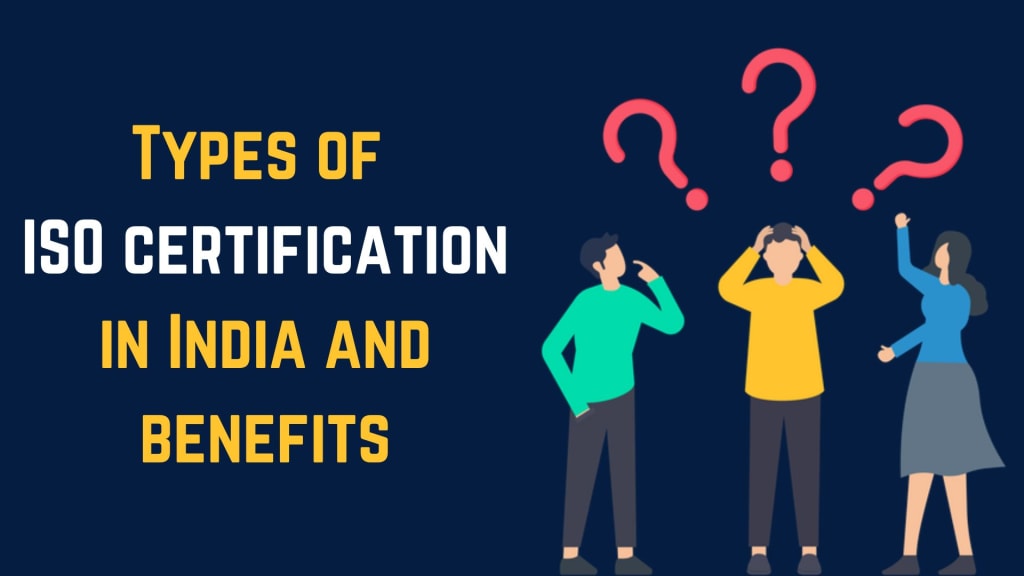What is ISO certification in India?
ISO (International Organization for Standardization) certification is a process that certifies an organization meets the requirements of a specific ISO Standard. The certification process involves verifying the organization’s quality management system, processes, products, and services against the requirements of the relevant ISO standard. In India, ISO certification is issued by the Quality Council of India (QCI).
Now we will know about Types of ISO Certification in India:
- ISO 9001: Quality Management System
- ISO 14001: Environmental Management System
- ISO 22000: Food Safety Management System
- ISO 27001: Information Security Management System
- OHSAS 18001: Occupational Health and Safety Management System
- ISO 50001: Energy Management System
- ISO/TS 16949: Automotive Quality Management System
- ISO 45001: Health and Safety Management System
Know about Benefits of ISO Certification in India:
There are many benefits of ISO certification in India which are explained below step by step.
- Improved customer satisfaction: ISO certification demonstrates your commitment to quality, which can help to increase customer confidence and satisfaction.
- Improved operational efficiency: ISO certification helps organizations to identify and eliminate inefficiencies, resulting in improved operational efficiency.
- Reduced costs: ISO certification can help to reduce costs by eliminating waste and increasing efficiency.
- Improved reputation: ISO certification can help to improve an organization’s reputation and credibility.
- Increased market share: A consultant of ISO certification in India can help organizations to gain an edge over their competitors, resulting in increased market share.
- Access to new markets: ISO certification can give organizations access to new markets and customers.
How Does ISO Certification in India Work?
ISO certification in India works by providing organizations with a set of standards to meet in order to achieve certification. To become certified, organizations must demonstrate that they have implemented a quality management system that meets the specific requirements outlined by the certification body. The certification body will then evaluate the organization’s system to ensure that it meets all the requirements. If the organization is found to be compliant, it will be issued with an ISO certification, which is valid for three years.
What is the process of ISO 9001 Documentation Work?
ISO 9001 documentation is a critical component of implementing and maintaining a Quality Management System (QMS) that complies with the ISO 9001 standard. The purpose of ISO 9001 documentation is to ensure that your organization has a systematic approach to quality management, which results in consistent and high-quality products or services. Here’s how ISO 9001 documentation works:
1- Development of a Quality Manual
The ISO 9001 documentation process typically starts with the development of a Quality Manual. This manual provides an overview of your organization’s QMS and serves as a high-level document outlining your commitment to quality and your approach to meeting the ISO 9001 standard’s requirements.
2- Identification of Processes
Your organization must identify and document all relevant processes and interactions within the QMS. These processes can include everything from product design and manufacturing to customer service and support.
3- Documentation Hierarchy
ISO 9001 documentation follows a hierarchy that includes various levels of documents, such as:
- Quality Manual: At the top level, providing an overview of the QMS.
- Procedures: Detailed descriptions of specific processes.
- Work Instructions: Step-by-step instructions for tasks within the procedures.
- Forms and Records: Documents that provide evidence of compliance and performance.
4- Procedures and Work Instructions
Procedures are documents that describe how specific processes are carried out in your organization. They provide a structured framework for consistent execution. Work instructions provide detailed, step-by-step guidance for tasks within these procedures.
5. Forms and Records
Forms and records are used to capture data and evidence of actions taken within the QMS. This includes records of internal audits, corrective actions, customer feedback, and more. They serve as objective evidence that processes are being followed and objectives are being met.
6. Control of Documents
Document control is a fundamental part of ISO 9001 documentation. It ensures that all documents are consistently managed, including creation, approval, distribution, access, and revision. Document control minimizes the risk of using outdated or incorrect documents.
7.Internal Audits
Regular internal audits are conducted to assess the effectiveness of the QMS and the compliance of documented procedures. This process of ISO certification in Hyderabad ensures that the QMS is continually reviewed, improved, and kept up to date.
8. Management Review
Top management reviews the QMS and associated documentation to assess its suitability and effectiveness. The management review process often results in changes to documented procedures and processes to improve the QMS.
9. Continuous Improvement
ISO 9001 documentation supports the principle of continuous improvement. When non-conformities or areas for improvement are identified, corrective and preventive actions are documented and implemented to rectify issues and prevent their recurrence.
10. External Audit
To achieve ISO 9001 certification, an accredited certification body will perform an external audit to evaluate your QMS and documentation for compliance with the ISO 9001 standard.
11. Certification and Ongoing Compliance:
If your QMS and documentation are found to be in compliance with ISO 9001, your organization will be awarded certification. To maintain certification, ongoing compliance and periodic surveillance audits are required.
In summary, ISO 9001 documentation is a structured and systematic approach to quality management within your organization. It involves the development, maintenance, control, and continuous improvement of various documents, procedures, and records that collectively ensure consistent quality and compliance with the ISO 9001 standard. Effective documentation supports your organization’s commitment to delivering high-quality products or services and helps it achieve and maintain ISO 9001 certification.


